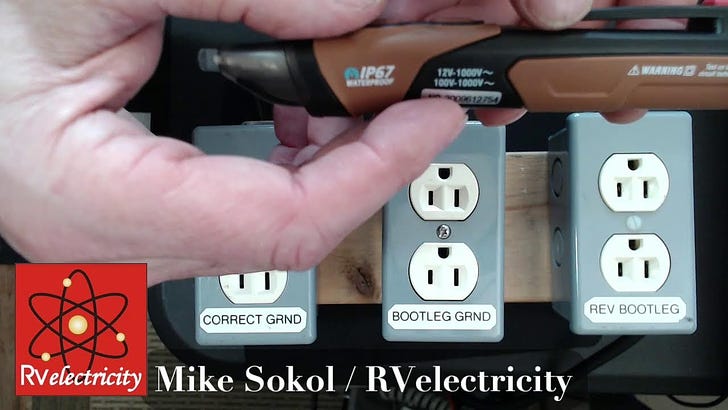Non-Contact Voltage Tester Theory Part-1
Who shall test the testers? Quis custodiet ipsos custodes?
Dear Mike,
I just finished reading your book “RV Electrical Safety” twice. You have demystified things I’ve only guessed at for years. I now feel more comfortable working around the pedestal and connecting my RV to shore power at campsites. Thanks for all that you do to help keep us RVers safe around electricity.
I have a 30-amp outlet on the side of my house and I decided to check it with the techniques you described in the book. There are two outlets in the box, the 30 amp and a 20 amp. I checked both with the non-contact tester and it showed no hot contacts. I assumed the breaker had tripped.
I then plugged in a 3-light outlet tester and it showed the 20-amp outlet was correctly wired. Is this 3-light tester self-powered or does it need power from the contacts to operate? If the latter, I don’t understand the reading from the non-contact tester. My NCVT is a Fluke VoltAlert 1AC-A II. I just got it for Christmas and used it inside the house to check some wall outlets and it worked fine (and so did the outlets). I’m pretty sure it was turned on, but I’ll go test the RV outlets again and check the circuit breaker. —Bruce
Dear Bruce,
Yes, the 3-light tester gets its power from the outlet itself. And you do need to verify that your Non-Contact Voltage Tester is working properly by first trying it on a known powered outlet. Since you confirmed the outlet has voltage with the 3-light tester, I’m guessing that something is wrong with your Non-Contact Voltage Tester itself or your own test procedure. Could be that it’s non-operational, the batteries are dead, it’s not turned on, or you’re using it improperly.
Here’s a video on how to test an outlet with a NCVT
Here’s how to test for an RV hot-skin with a NCVT
Always test your testers! (Who will guard the guards?)
When working with any type of electrical test gear, be it a voltmeter or an NCVT, you first need to confirm that it’s turned on and operational by checking it on a known good power source before using it to test an unknown outlet.
And note that any NCVT can only confirm the presence of voltage, not the absence of voltage. That is, if it does beep at you, then it’s a sure indicator that the NCVT is detecting some kind of voltage. But if it doesn’t beep at you, then it’s possible that the NCVT batteries are dead, it could be turned off, or you might simply be using an improper testing technique.
An NCVT is not the gold-standard for voltage testing – it’s just a really quick test method you can use anytime. But if anything looks the least bit off about a campground pedestal or electrical outlet in your home, then you need to get out a real voltmeter and do a deeper level test.
Let’s play safe out there… Mike






The non contact volt tester will detect the presence of any kind of electricity. What I do is rub the tester against the clothes I'm wearing to create static electricity. Sometimes you're not around another source of power to pretest and post test the tester but, it will detect static electricity. So, before AND after I test for the presence of AC volts, I test for static electricity. Simple and easy and unless it's crazy humid, this works every time. If I don't get a reading, I really want to know that my tester is really working or maybe if using a multimeter, a lead has failed.